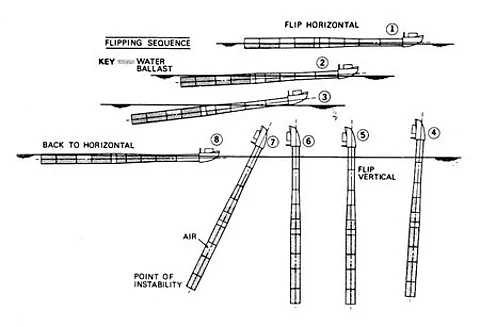

The 'RP FLIP' (Floating Instrument Platform), claimed to be the world's only 'flipping' open ocean research vessel, celebrates its 50th anniversary this year.
Owned by the United States Navy's Office of Naval Research and operated by the Scripps Institution of Oceanography, the 108 metre 'RP FLIP' is designed to be towed into place in its horizontal orientation, then 'flipped' vertically through ballast changes to become a stable research platform.
The 'flipping' procedure takes approximately 30 minutes to complete, with passengers and crew posted outside during the procedure.
When flipped, most of the buoyancy for the platform is provided by water at depths below the influence of surface waves, hence the vessel is a stable platform mostly immune to wave action, like a spar buoy.
At the end of a project, compressed air is pumped into the ballast tanks in the flooded section and the vessel returns to its horizontal position so it can be towed to a new location.
The 700GRT vessel is designed to study wave height, acoustic signals, water temperature and density, and for the collection of meteorological data.
Because of the potential interference with the acoustic instruments, the vessel has no engines or other means of propulsion. It must be towed to open water, where it drifts freely or is anchored. In tow, the 'RP FLIP' can reach speeds of 7–10 knots.
The vessel is designed to accommodate passengers and crew in both horizontal and vertical positions, leading to a unique and sometimes bizarre layout, with doors mounted on the floor, portholes in the ceiling, tables bolted sideways to walls, and stairs seemingly leading to nowhere.
In operation since 1962, the 'RP Flip' has supported science in a variety of locations across a spectrum of research projects, including acoustics, marine mammal research, geophysics, meteorology, physical oceanography, and laser propagation experiments.
The ship is frequently mistaken for a capsized ocean transport ship.
Image source: Scripps Institution of Oceanography
